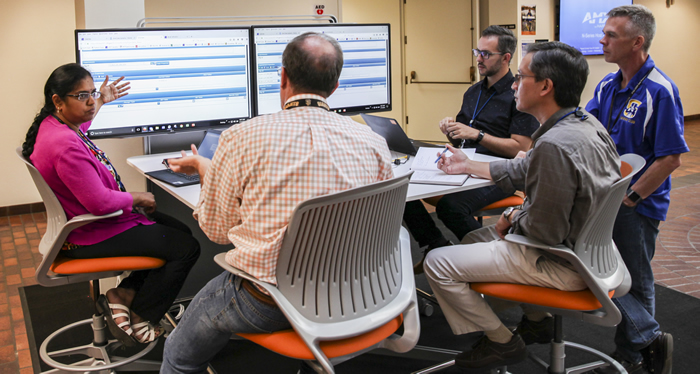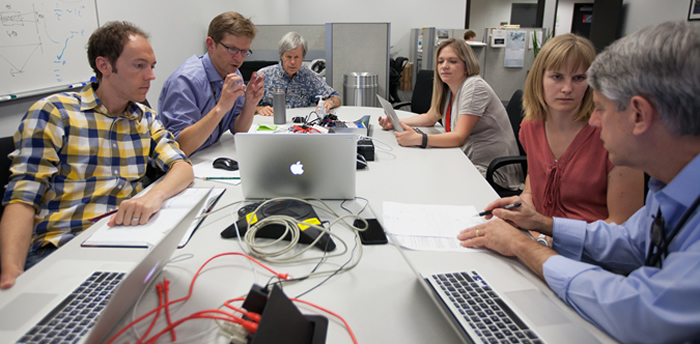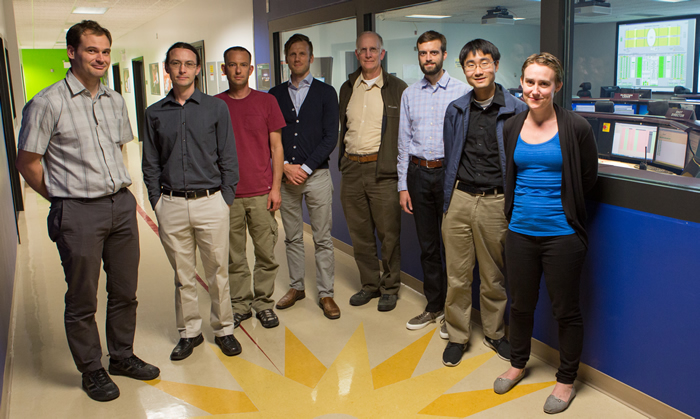The NIF User Office:
Where the World Meets the Laser
“NIF’s technical capabilities are truly spectacular, and have empowered new research collaborations that have led to significant breakthroughs in understanding the formation and evolution of planets.”
—Raymond Jeanloz, professor of astronomy and earth and planetary science at UC Berkeley
Because NIF is a one-of-a-kind facility, it offers opportunities for research that were impossible a decade ago and are still unavailable anywhere else in the world. The NIF User Office supports the scores of researchers across the Department of Energy laboratory system and thousands of their colleagues in academia and industry around the world who compete to conduct experiments at NIF.
Its goal is to cultivate innovations that benefit the scientific community as well as Livermore’s missions of supporting stockpile stewardship and fundamental science research.
User Office Director Kevin Fournier’s committed team of scientists, engineers, and support staff strives to simplify and streamline the process of doing research at NIF. Their efforts have led, among other improvements, to an integrated suite of new tools for proposing, planning, and conducting shots on NIF.
 A NIF development team— (from left) Bhanu Vuppala, former member Bob Burr, Derrick Lassle, Robert Fallejo, and Kevin Fournier—works with one of the new Web-based tools utilized by the NIF User Office. Credit: Mark Meamber
A NIF development team— (from left) Bhanu Vuppala, former member Bob Burr, Derrick Lassle, Robert Fallejo, and Kevin Fournier—works with one of the new Web-based tools utilized by the NIF User Office. Credit: Mark Meamber Using the Salesforce™ platform, Fournier’s team and the NIF Data Systems group have centralized the submission and evaluation process, making everything simpler for both the scientists proposing experiments and the Technical Review Committee—the panel of experts from the HED science community that evaluates the proposals for scientific merit.
- The Shot Setup Tool helps define the facility parameters necessary to fire the laser-to-target shots;
- The Shot Request Tool allows experiments to be scheduled alongside other shots with similar parameters; and
- The Target Request Tool enables NIF’s Target Fabrication team to take the scientists’ plans for the target and make them real.
Once a shot is completed, the resulting data is archived and packaged on a Web interface so the researchers can view a wide variety of diagnostic information.
 Artist’s illustration of the potentially life-supporting “super-Earth” planet K2-18b (upper right) and its recently discovered neighbor, K2-18c. Both planets orbit in the habitable zone of the red-dwarf star K2-18, which lies 111 light-years from Earth in the constellation Leo. K2-18b, about 2.2 times bigger than Earth, was discovered in 2015 by researchers using NASA’s Kepler space telescope. Credit: Alex Boersma
Artist’s illustration of the potentially life-supporting “super-Earth” planet K2-18b (upper right) and its recently discovered neighbor, K2-18c. Both planets orbit in the habitable zone of the red-dwarf star K2-18, which lies 111 light-years from Earth in the constellation Leo. K2-18b, about 2.2 times bigger than Earth, was discovered in 2015 by researchers using NASA’s Kepler space telescope. Credit: Alex Boersma Discovery Science experiments conducted by NIF users range from deep in the Earth to the far reaches of the universe. Basic science research on the core density of supermassive Earth-like planets has not only helped astrophysicists better understand planet formation, it has helped Stockpile Stewardship Program (SSP) scientists develop techniques to examine how weapons materials behave at immense pressures. Scientists studying proton behavior in magnetic fields have provided useful data for the SSP program as well. The User Office’s work has as many benefits as NIF itself.
 Members of a Discovery Science team using x-ray Thomson scattering to study ionization balance plan their experiment (from left): Benjamin Bachmann, Tilo Döppner, Joe Nilsen, and Annie Kritcher of LLNL and Alison Saunders and Roger Falcone of UC Berkeley. Credit: Jason Laurea
Members of a Discovery Science team using x-ray Thomson scattering to study ionization balance plan their experiment (from left): Benjamin Bachmann, Tilo Döppner, Joe Nilsen, and Annie Kritcher of LLNL and Alison Saunders and Roger Falcone of UC Berkeley. Credit: Jason Laurea Examples of NIF Users and Partners
- Academic: MIT, University of Michigan, Oxford University (UK), French Alternative Energies and Atomic Energy Commission (CEA), Osaka University (Japan), Princeton University, the Hebrew University (Israel), University of Rostock (Germany), UC San Diego, UCLA, UC Berkeley, UC Davis, UC Santa Cruz, Washington State University, University of Maryland, Ohio State University, University of Nevada Reno, University of Chicago, Carnegie Institute (St. Louis, MO), University of Edinburgh (Scotland), Stanford University, The George Washington University, and others.
- Government: Missile Defense Agency (Huntsville, AL), Defense Threat Reduction Agency (Ft. Belvoir, VA), U.S. Navy Strategic Systems Program, Department of State, Department of Homeland Security, and others.
- Private Companies: 5th Gait Technologies (Huntsville, AL and, Santa Barbara, CA), Peraton (Colorado Springs, CO), Raytheon Missile Systems (Tucson, AZ and Sunnyvale, CA), and others.
Other partners in NIF experiments, diagnostic and target development, and other activities include Los Alamos and Sandia national laboratories, General Atomics, the Laboratory for Laser Energetics at the University of Rochester, and the Atomic Weapons Establishment in the United Kingdom.
Many more partners—small and medium-sized companies as well as universities—support diagnostic development, optics fabrication, facility infrastructure projects, and other aspects of NIF operations.
 Members of a Discovery Science team studying stellar and Big Bang nucleosynthesis on NIF (from left): Daniel Sayre (LLNL), Daniel Casey (LLNL), Charles Yeamans (LLNL), Matthias Hohenberger (Laboratory for Laser Energetics, University of Rochester), Bruce Remington (LLNL), Alex Zylstra (LLNL), Hong Sio (MIT), and Maria Gatu Johnson (MIT). Gatu Johnson received the 2019 Katherine E. Weimer award from the American Physical Society’s Division of Plasma Physics for outstanding achievement in plasma science research by a woman physicist in the early years of her career. Credit: Jason Laurea
Members of a Discovery Science team studying stellar and Big Bang nucleosynthesis on NIF (from left): Daniel Sayre (LLNL), Daniel Casey (LLNL), Charles Yeamans (LLNL), Matthias Hohenberger (Laboratory for Laser Energetics, University of Rochester), Bruce Remington (LLNL), Alex Zylstra (LLNL), Hong Sio (MIT), and Maria Gatu Johnson (MIT). Gatu Johnson received the 2019 Katherine E. Weimer award from the American Physical Society’s Division of Plasma Physics for outstanding achievement in plasma science research by a woman physicist in the early years of her career. Credit: Jason Laurea More Information:
“NIF Users Bring Ideas and Energy to Discovery Science”
“Laser Experiments Illuminate the Cosmos,” Science & Technology Review, December 2016
Next Up: Education and Outreach



